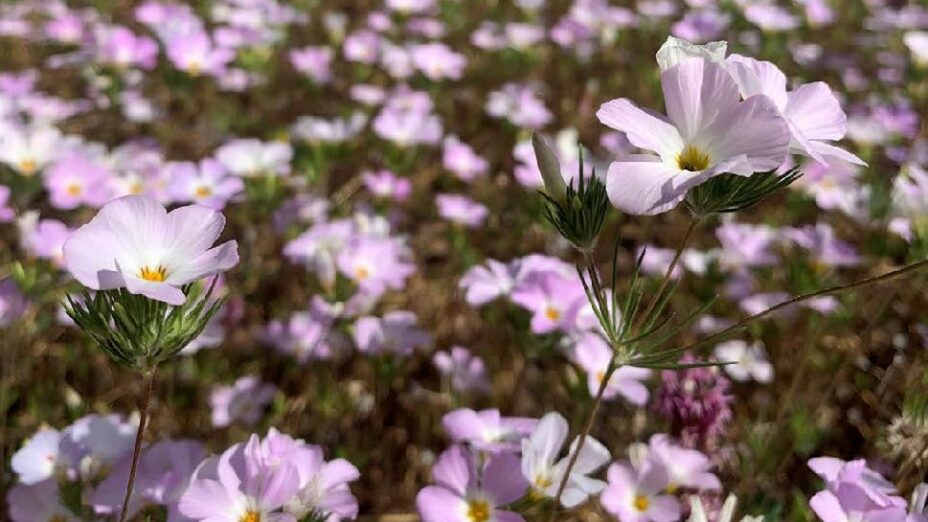
Stewardship Update
Written by Haley Sutton, Land Stewardship Associate
Mangini Ranch Interpretive Gardens
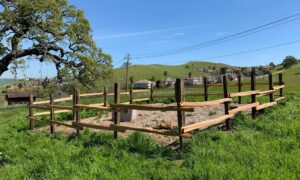
Finished split-rail fence around Mangini Ranch Educational Preserve interpretive garden. Photo by Haley Sutton
Staff completed the split-rail fence installation around the native interpretive gardens at Mangini Ranch Educational Preserve.
De La Salle and Campolindo High School students set up the sheet mulch and installed the vertical posts during previous Conservation Collaboration Agreement field days, and Diablo Restoration Team volunteers planted the first round of natives in the gardens.
We encourage you to make a reservation at the Mangini Preserve to see the flourishing natives and explore the flora around the rest of the preserve.
Curry Canyon Ranch Beautification

Diablo Restoration Team volunteers clearing weeds from gravel outside Curry Canyon Ranch field station. Photo by Haley Sutton
Many volunteers joined us at the Curry Canyon Ranch for some spring cleaning around the field station. Together they removed all the tiny pesky weeds from the gravel and pavers surrounding the property.
Volunteers were rewarded with a beautiful day with excellent views of the Mount Diablo summit.
Stewards in the Field
Trail Dogs refurbished the Coralwood Trail at Mangini Ranch Educational Preserve, Twin Ponds Loop Trail in Shell Ridge Open Space, and Coyote Trail at Morgan Territory Regional Preserve. They also removed fencing at Black Diamond Mines Regional Preserve.
Stewards protected additional oak seedlings at Oak Hill Lane, and continued to observe copious wildflowers and flowing creeks across all Save Mount Diablo properties.
Join Us!
Adopt-a-Crag Diablo Restoration Team Workday – May 26th at Curry Point, 9 AM to 1 PM
Discover Diablo Program
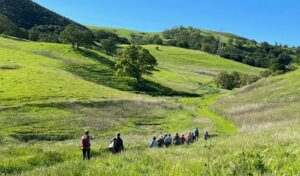
Discover Diablo event: Sauntering & Soloing. Photo by Steve Balling
April 1st Medicinal Herb Walk in Mitchell Canyon: participants learned some of the California native plants that people have evolved with from a professional herbalist.
April 2nd Mitchell Canyon Wildflower Hike: participants spotted lilies galore, including globe lilies and a checkered lily.

Mount Diablo globe lily (Calochortus pulchellus). Photo: Scott Hein
April 13th Mangini Ranch Sauntering and Soloing: everyone participated in some grounding exercises during a beautiful day.
April 13th Castles and Peregrine Falcons: attendees observed copious wildflowers and birds, including two posing peregrine falcons in Diablo Foothills Regional Park.
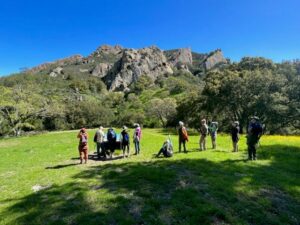
Discover Diablo event: Castles and Peregrine Falcons. Photo by Jennifer Russell
April 14th Wonderful Wildflowers: participants saw an array of flowers in bloom near the summit of Mount Diablo.
April 21st Wildflowers of Mary’s Trail: participants observed all that’s in bloom near the Mount Diablo summit with 360 degree views around the mountain.
Thank you to our Discover Diablo volunteers! Sign up for any of the Discover Diablo Events through Eventbrite.
BioBlitz
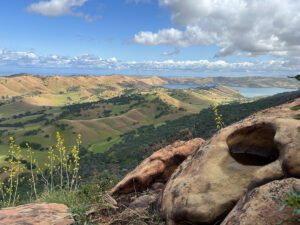
Golden eardrops with a view to Los Vaqueros. Photo by Sean Burke
Save Mount Diablo’s two-week BioBlitz (April 15th–April 30th) focusing on the SCU Lightning Complex fire footprint has ended.
This year was the third and final focusing on the SCU Lightning Complex fire footprint in partnership with California Native Plant Society and their Fire Followers iNaturalist campaign.
We had 1,014 observations uploaded onto iNaturalist during the two-week period from 54 observers.

Wildflowers in Henry W. Coe State Park. Photo by by Bruce and Joan Hamilton
There were thousands of fire followers across the fire footprint, including fire poppies, golden eardrops, and whispering bells. Participants saw chaparral plants growing even more after last year’s growth.
This is our third and final year focusing on this fire footprint, and the vegetation is much denser than it was in 2021 and 2022. Thank you to everyone who participated in Save Mount Diablo’s 2022 BioBlitz!
Please sign up for our recap events on May 17th from 4 to 6 PM.
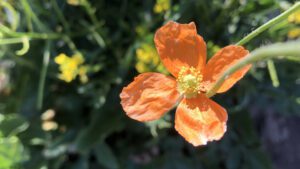
Fire poppy. Photo by Denise Castro.
Top: Large-flowered leptosiphon (Leptosiphon grandiflorus) at Henry W. Coe State Park. Photo by Haley Sutton

